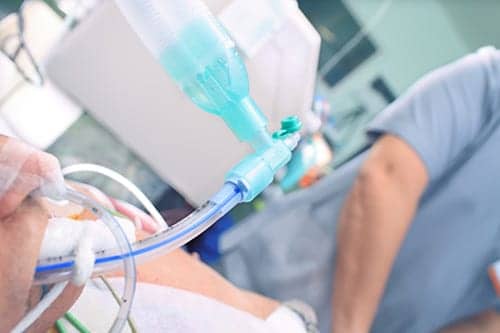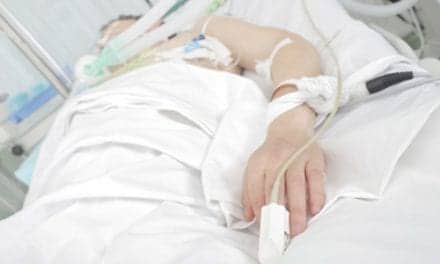Neuromuscular respiratory failure is the most common cause of death in patients with amyotrophic lateral sclerosis (ALS), usually within two to five years of the disease onset.
Approximately 6,000 individuals in the United States are diagnosed annually with amyotrophic lateral sclerosis (ALS), a disease that affects nerve and muscle functioning, according to the ALS Association. Also known as Lou Gehrig’s disease, ALS typically develops between the ages of 40 and 70, although adults in their 20s and 30s have also been diagnosed with the disease. The ALS Association reports that post-diagnosis patients live at least three years; 20% survive for five or more years and approximately ten percent have a longer lifespan of more than ten years. While research has not identified specific risk factors, medical advances have led to clinical management approaches that can improve quality of life and survival rates.
One of the most widely used interventions for ALS is noninvasive ventilation (NIV). But the decision to initiate NIV has not been refined. A recent study examined the role of respiratory function tests in determining the optimal time to begin NIV.1 The researchers evaluated five respiratory function tests in patients with ALS: forced vital capacity (FVC); peak cough flow (PCF); maximum inspiratory and expiratory pressure (MIP and MEP); and sniff nasal inspiratory pressure (SNIP). Their goal was to identify which test or tests showed the best predictive value for introducing NIV. Findings showed that all test results trended downward as the disease progressed, but SNIP and PCF demonstrated the biggest decline, offering researchers the best indication of when to initiate NIV.
Monitoring with NIV
Neuromuscular diseases, such as ALS, present with a number of symptoms directly related to respiratory failure, including overall weakness; dyspnea, both on exertion and at rest; fatigue and sleepiness; dysphagia; headaches upon wakening; difficulty concentrating; mood changes; and hypoventilation – particularly at night.
The American Academy of Neurology’s ALS Practice Parameters recommend NIV “…to treat respiratory insufficiency in ALS to lengthen patient survival,” according to Denise Hartsell, RRT, RPSGT, Senior Product Manager, Ventilation at ResMed. She indicated that both bilevel and life support devices offer NIV capabilities. “Bilevels, such as ResMed’s AirCurve ST-A, are generally reserved for NIV administration in patients with an early diagnosis,” Hartsell said. “Because ALS is a progressive disease, many patients receive NIV via a life support device, like ResMed’s Astral ventilator, which can be utilized throughout the course of the disease. Astral has safety features, such as a full suite of alarms and an internal battery, that become important as the disease progresses.”
Most devices have the ability to monitor basic ventilation parameters, such as usage, respiratory rate, tidal volume, minute ventilation and peak inspiratory pressures, which are key to assessing patient stability. However, respiratory monitoring devices have different capabilities depending on the manufacturer, Hartsell noted. “Oftentimes, additional objective parameters like oximetry can be reported with the use of ancillary accessories. ResMed devices have the ability to save 365 days of data to the device’s memory, and to send that data to clinicians via its cloud-based AirView platform, so they can remotely monitor their patients,” she said, adding that objective data reporting can alert clinicians when a patient requires alternative therapy. For example, monitoring nocturnal oximetry can effectively detect early respiratory insufficiency and identify the need for early use of NIV. Detailed data collection also facilitates troubleshooting and monitoring patient progress.
Customizing Devices
Every patient diagnosed with ALS presents with unique symptoms and challenges. Customizable ventilators with features such as multiple program settings, a full suite of synchrony features and multiple circuit configurations, enable clinicians to address each patient’s needs. “Customizable programs allow for therapies like mouthpiece ventilation during the day, which many ALS patients benefit from, and an alternate nighttime mode for improved ventilation during sleep. Roughly 40% of NIV patients will experience asynchrony, so it is key to have adjustable synchrony features, such as Astral’s Ti Control, Rise Time, and Trigger and Cycle adjustments,” Hartsell said. “ResMed’s Astral also accommodates various circuit configurations, including the double limb circuit, which can provide care more aligned with that of a hospital environment, which may be necessary given a patient’s disease progression.”
In many cases, ALS patients present with comorbid obstructive sleep apnea (OSA), which requires careful oversight to prevent upper airway collapse. ResScan shows high-resolution flow data that can help determine appropriate titration and maintain and open airways.
Although ventilators may be customized for each patient, acceptance of the therapy, whether invasive or not, depends on a number of factors, including comorbid conditions, such as OSA. “Factors that can improve patient compliance are things such as early intervention with NIV, those patients that have NIV initiated at a younger age, those with preserved upper limb function and those with preserved cognitive function,” said Hartsell. “Patients with bulbar involvement tend to have lower compliance with NIV. Unfortunately these are all factors that cannot be resolved by the choice of the NIV device.”
For patients with worsening ALS coupled with bulbar dysfunction, tracheostomy might be necessary to bypass the mouth muscles and provide better upper airway management. Italian researchers found that ALS patients who were treated with tracheostomy-intermittent positive-pressure ventilation (TIPPV) had a median survival rate of 49%.2 The study asserted that TIPPV “…is a relatively safe intervention that allows long-term survival for patients with respiratory failure, who cannot tolerate, or have contra-indications for NIV.” Furthermore, patients and caregivers were, for the most part, satisfied with the decision to initiate TIPPV.
Although experts believe tracheostomy provides a better connection than NIV, the decision to initiate this approach should be shared between clinical caregiver and patient, according to a 2017 study.3
ALS caregivers face several challenges and require an all-inclusive training program at initial home setup, according to Hartsell. She pointed out, “…given the complexity of care required, training programs should be viewed as continual skills training. All caregivers should be trained on the home ventilator and accessories, as well as the care and maintenance of the ventilator,” Hartsell said. “Device training will often require a little ‘Buttonology 101,’ that is, learning what each of the device’s buttons do, how to monitor the patient’s parameters and responding to alarms. All caregivers also should receive ventilator user guides and any available video tutorials, and particularly be familiar with emergency procedures, such as what to do during a home power failure.”
Integrated Devices
In addition to appropriate ventilation and oxygen delivery, ALS patients often require cough assist, suctioning and nebulization. In 2013, Doug DeVries, Ventec Life Systems founder, worked with a team of engineers to design an all-in-one device that would address these issues and facilitate patient mobility. His father had been had been diagnosed with ALS and DeVries witnessed first-hand the impact the disease had on both the patient and caregivers. After years of research and development Ventec Life Systems created Ventec One-Circuit (VOCSN), which tracks ventilation, oxygen, cough, suction and nebulization on one device.
According to Craig Morris, Ventec Life Systems Clinical Liaison, VOCSN is a critical care ventilator intended for adult and pediatric patients 5 kg and above that can be taken from the hospital to the home. “The simplicity and everyday mobility of the VOCSN integrated respiratory system, makes it ideal across the continuum of care including hospital, medical transport, long term care and home care environments,” he said.
VOCSN was designed in close consultation with patients and caregivers to resolve some of the biggest pain points with traditional technologies, according to Morris. “We solicited feedback from hundreds of users, including medical professionals and non-medical professionals, to design a simple system that works more like your cell phone than a complicated medical device,” he said. “With just a quick introduction to the operating system, even users without a background in respiratory care can easily navigate VOCSN.”
VOCSN is 70% lighter and smaller than existing technologies and includes up to nine hours of on-board battery, which allows for increased patient mobility. Moreover, VOCSN reduces the risk of infection since the user can switch between therapies by touching a button without disconnecting the circuit. Morris said, “VOCSN reduces the anxiety for patients and creates time for caregivers. With VOCSN, caregivers can spend less time managing machines and spend more time interacting with patients.”
Traditional technologies require ALS caregivers learn, monitor and maintain multiple devices; the VOCSN integrated operating system simplifies the process, while tracking all five therapies on one device. “The integrated VOCSN therapy tracker stores the most recent 7,300 event, alarm and settings change records across all five therapies so caregivers can better manage patient compliance to the doctor’s orders,” said Morris. “For example, an RT taking over on night shift can walk into a patient’s room, look at the VOCSN therapy tracker screen and see exactly when the last cough and suction therapy was administered and all of the settings for the therapies as delivered.”
Changing Technology
Similar to the way the iPhone changed the way the world communicates and how we organize our lives, VOCSN fosters different thinking when it comes to the patient and caregiver experience, Morris reports. “The entire idea of integration creates new possibilities and eliminates many of the daily challenges of patient care,” he said, pointing out that one device to learn, manage, transport and clean means therapies can be completed in seconds instead of minutes. “Prior to VOCSN, nobody ever imagined a need for a technology like this because the idea of a ventilator and cough assist working together had never been possible. We will have to think differently and evolve our thinking to adopt new technology that has been absent from the world of respiratory care for nearly two decades.”
ALS is a progressive disease and, for that reason, requires continual monitoring, whether through NIV, TIPPV or an integrated device. Rapidly advancing technology is helping clinicians, patients and caregivers improve quality of life and extend lifespans for those diagnosed with ALS. RT
Phyllis Hanlon is a contributing writer of RT Magazine. For more information please contact [email protected].
References
- Tilanus TBM, Groothuis JT, TenBroek-Pastoor JMC et al. “The predictive value of respiratory function tests for non-invasive ventilation in amyotrophic lateral sclerosis.” Respiratory Research 2017; 18:144. DOI 10.1186/s12931-017-0624-8.
- Marchese S, Lo Coco D, Lo Coco A. “Outcome and attitudes toward home tracheostomy ventilation of consecutive patients: A 10-year experience.” Respiratory Medicine. 2008; 102:430-436. DOI: 10.1016/j.rmed.2007.10.006.
- Ceriana P, Surbone S, Segagni D, et al. “Decision-making for tracheostomy in amyotrophic lateral sclerosis (ALS): a retrospective study.” Amyotrophic Lateral Sclerosis and Frontotemporal Degeneration; 2017 Apr 29:1-6. DOI: 10.1080/21678421.2017.1317812.











Great Article! I would love to discuss bringing this product to Southern Ca, I am a Neuro-Respiratory Specialist at Loma Linda University. I run the Respiratory spectrum for our multi disciplinary clinic. I work with a dietician named Kelli Davis her cousin is Mike Holmes on your team (small world) Please contact me at your earliest convince.
Kind Regards,
Andrea Fritsch, RCP RRT